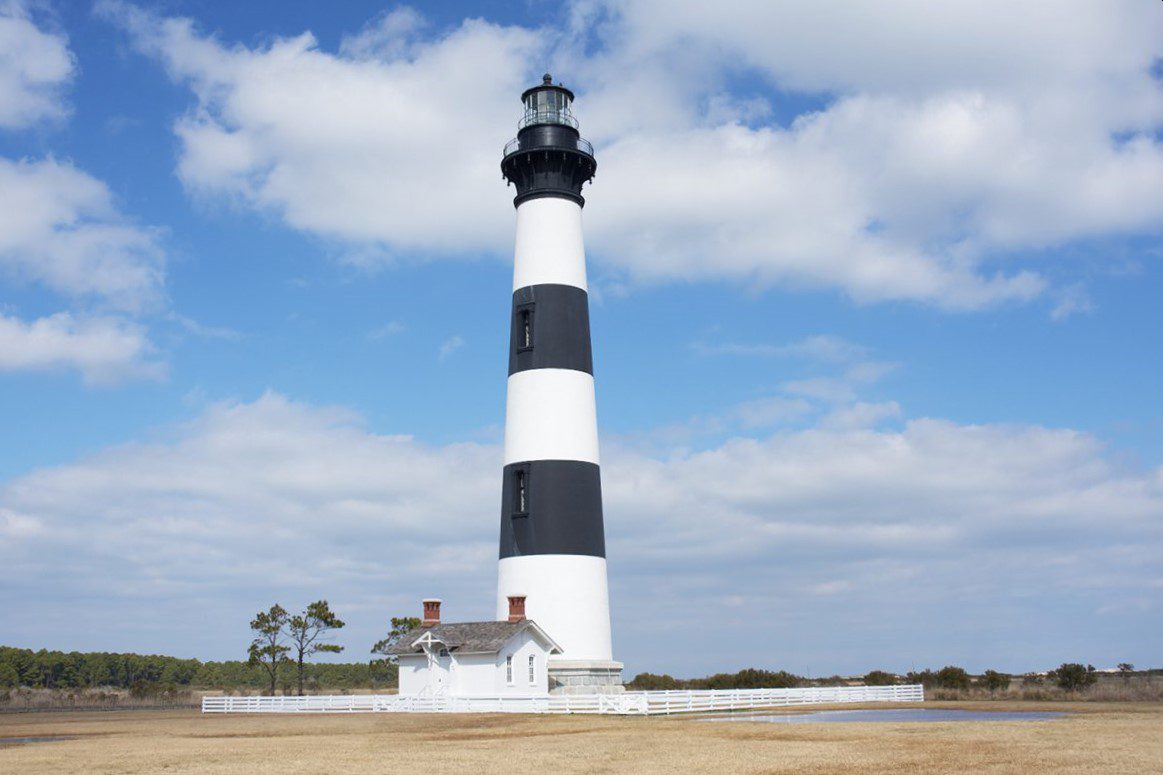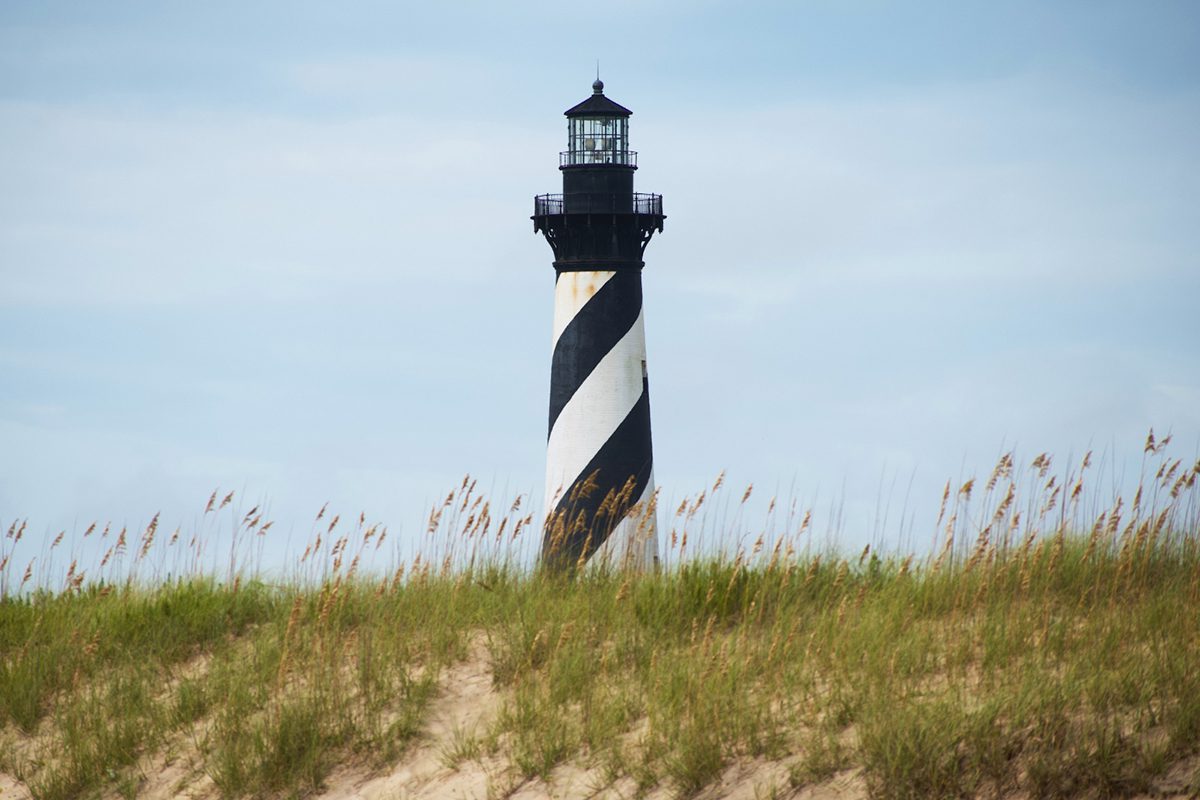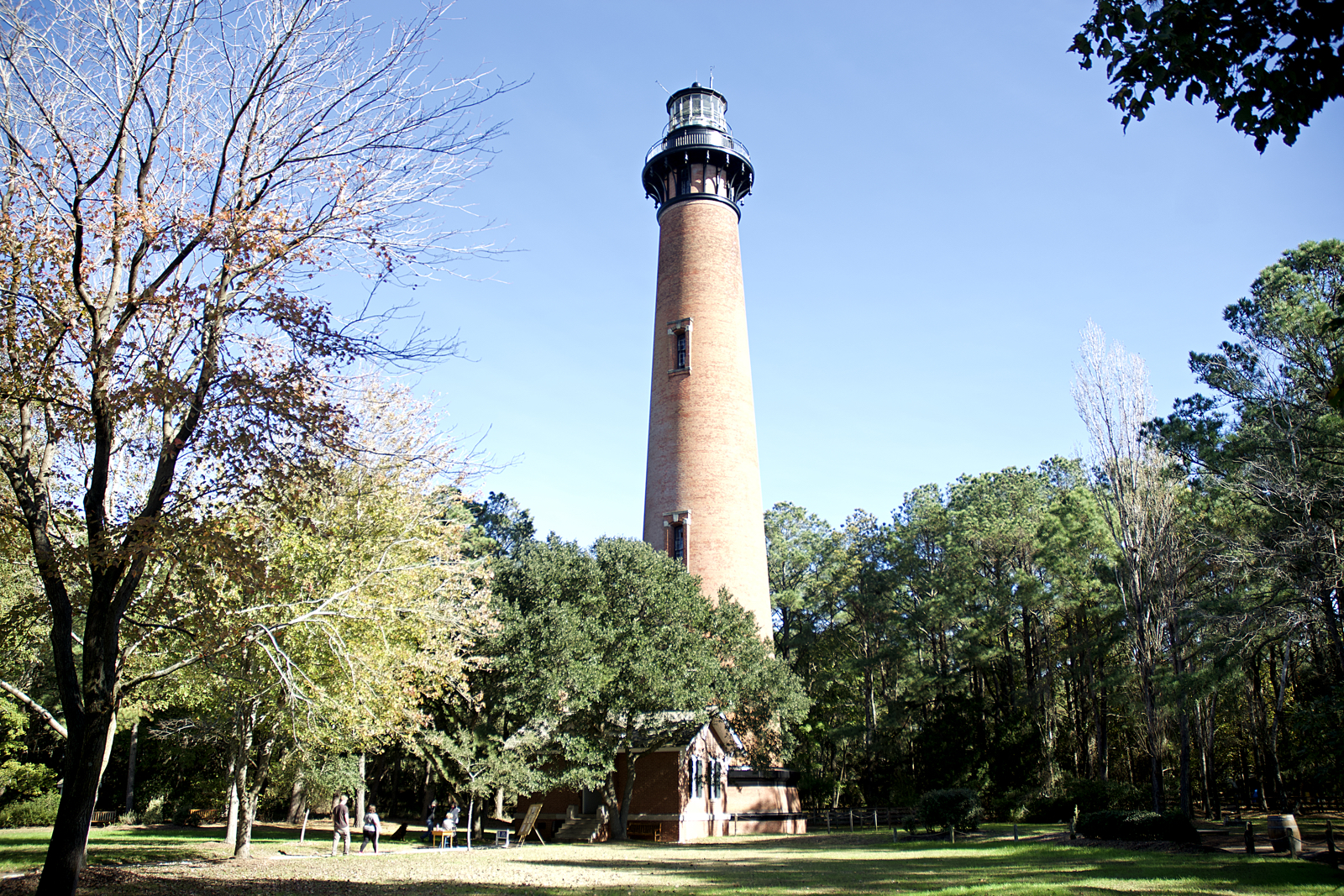
This post has been updated to include additional information on Currituck Beach Lighthouse provided by Outer Banks Conservationists nonprofit organization.
The three lighthouses north of Ocracoke on the Outer Banks, Cape Hatteras, Bodie Island and Currituck Beach, built between 1869 and 1875, have withstood hurricanes, nor’easters and the harsh coastal environment, although the Hatteras light was moved landward in 1999 to spare it from the encroaching Atlantic.
Supporter Spotlight
The trio all share design features that were introduced with the Hatteras light, which was first lit Dec. 16, 1870, and they all have in common construction supervisor Dexter Stetson, a Massachusetts native who brought his church construction expertise and innovations to the projects.
The Cape Hatteras Lighthouse was the nation’s third attempt at providing a beacon to warn mariners about deadly Diamond Shoals. The first light tower at Hatteras had been built in 1803 but was only 90 feet tall, too short to be effective. In 1853, the tower was extended another 60 feet, but even at 150 feet and even with its first-order Fresnel lens the lighthouse was inadequate.
But the new lighthouse, once completed, was up to the task. The beam from the Fresnel lens was visible 20 nautical miles. And the foundation supporting the towering structure, which featured Stetson’s solution after conditions at the site had halted construction as designed, stood the tests of time and harsh coastal conditions.

Before construction of the Cape Hatteras Lighthouse was complete, the Lighthouse Board, the federal agency overseeing the nation’s lighthouses, was planning its next project on the Outer Banks, a new lighthouse for Bodie Island. Stetson’s written orders were dated June 19, 1871, from Capt. Peter Hains, lighthouse engineer for the 5th Lighthouse District.
“You will proceed without delay to Body’s Island, N. C., and commence the construction of the First Order Light house at that place in accordance with the drawings and instructions furnished you,” Hains wrote, advising that, “The L. H. at Body’s Island, the construction of which is placed in your charge, will be one of the most important on the Atlantic Coast and too much energy cannot be displayed in hastening its completion.”
Supporter Spotlight
A 2003 National Park Service historic structure document details the location selected for the new lighthouse as recorded in the report, “New structure at Body’s Island,” found in the National Archives.
Related: Ceremony set for Bodie Island Lighthouse’s 150th year
“The new site is 11/2 nautical miles north of Oregon Met, 3/4 mile from the Atlantic and 3/8 mile from Roanoke Sound. It is protected on the west by Roanoke Island from the action of storms tending to drive the waters of Pamlico Sound towards the sea. It is a square piece of land 15 acres in extent,” according to the document.
Hains prescribes how the structure was to be built, specifically referencing Stetson’s design for a stable foundation used for the just-completed Cape Hatteras Lighthouse.
“As the work you superintended at Cape Hatteras has rendered you familiar with the details and requirements of such a tower, as that to be built at Body’s Island, detailed instructions are not deemed necessary, the drawings being sufficiently explicit with general instructions. The foundation will be on grillage similar to that at Cape Hatteras tower the top of the grillage being six feet two inches below the surface of the ground,” he writes.
The grillage Hains references were pine beams that Stetson had used to shore the foundation for the Cape Hatteras Lighthouse.
“The lighthouse was set on a ‘floating foundation’ (two layers of pine beams placed crossways below the water table topped by massive granite blocks), which remained perfectly preserved for well over a century,” according to the lighthousefriends.com website.
In 1999, when the lighthouse was raised off its foundation and moved a half-mile away from the sea, the pine beams were intact and unharmed.
The original plans for Cape Hatteras Lighthouse called for the foundation to be on pilings driven into the sand. However, it quickly became apparent that the sand was too compacted to drive pilings, and project engineer J.H. Simpson wrote to the Lighthouse Board detailing Stetson’s solution.
“Pursuant to said instructions a bottom sounding iron rod, 1’4”…provided with a proper head and sharp point at its lower end was furnished Mr. Stetson, the Supt of Construction; but with all the battering possible it seems he could not make it penetrate the sand at the site of the Tower more than 9 feet … Indeed, he found when he reached the proper depth of excavation, the bottom so hard and compacted as to require no piling, and therefore mailing me … that he intended to place a double grillage platform immediately on the bottom.”
Stetson employed the same floating foundation design when building the Bodie Island Lighthouse, and again in 1873 when he began work on the Currituck Beach Lighthouse.
However, when Stetson drove his test borings into the sand at Currituck Beach, he found the soil was suitable for a foundation of pilings, the pilings driven 22’-24’ into the sand. Stetson’s grill design was still to be used to support the tower as described by Peter Hains, Major Engineer for the project in a January, 1874 letter to the Lighthouse Board.
“The piles are to be driven at distances apart of two (2) feet ten (10) inches,” he wrote. “They will then be sawed off at a depth of three and a half (3 ½) feet below the level of the water, then capped by 12”x12” timbers…At right angles to these pieces, another set of 12”x12” timbers will be laid…The grillage will then be eighteen inches thick. The open spaces are to be filled in with concrete…on which the masonry of the tower will rest,” according to information provided by Outer Banks Conservationists, which oversees the Currituck Beach Lighthouse.

Stetson’s qualifications
It’s not entirely clear why Stetson was initially chosen for the job of superintendent of construction.
According to his obituary published Dec. 1, 1899, in the Lynn, Massachusetts, Daily Evening, Stetson was born in Durham, Maine, Nov. 8, 1815.
In February 2006 the Nahant Harbor Review wrote that sometime in the 1840s he had moved to Lynn and in 1846 married Ann Maria Hood of Nahant, a small town on a peninsula that borders Lynn to the south. There, the couple made their home.
Stetson had gained a reputation as a skilled builder, according to the Nahant Review article. In the town, his most widely praised work was the village church built in 1852. The Nahant Harbor Review quotes Calantha Sears of the Nahant Historical Society who said, “It was built so well for $2,258 that part of a Sunday sermon included praise for Stetson on his handiwork.”
His successful work on the church was followed by a small political victory, having been elected a town selectman in Nahant, according to an April 4, 1853, report in the Richmond, Virginia, Daily Dispatch. “The town is one of the smallest in the Bay State containing only about 30 votes.”
In 1855, Stetson worked on his first lighthouse, the Egg Rock Lighthouse, near Nahant, according to historian and author Kevin Duffus.
Stetson was not the supervisor on the project. That was Ira P. Brown, and it is unclear exactly what Stetson’s role was. But the work led to government contracts, and just as the Civil War erupted, Stetson had taken work on the Gulf Coast.
“When the war broke out, he was in New Orleans, having charge of the building of several government buildings there. He had in his possession, a valise full of gold coin, the property of the government, and had considerable of a trip getting it back safely to New York,” the Lynn Daily Evening noted in Stetson’s obituary.
Later life
After completing the Currituck Beach Lighthouse Stetson returned to Nahant, remaining there until he died in 1899. Stetson’s mother’s maiden name was Dennison, and in a 1906 book by A.L. Dennison, “The Dennison Family,” the author describes Stetson’s life after returning to his hometown.
“He served the government thirty years and built some of the finest lighthouses on our coast. When he retired he received many complimentary letters from high officials of the Army and Navy for his integrity and efficiency,” Dennison writes.







